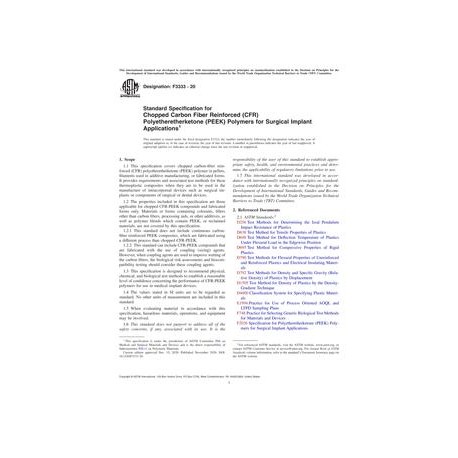No products
 View larger
View larger ASTM F3333-20
M00000612
New product
ASTM F3333-20 Standard Specification for Chopped Carbon Fiber Reinforced (CFR) Polyetheretherketone (PEEK) Polymers for Surgical Implant Applications
standard by ASTM International, 11/15/2020
In stock
More info
Full Description
1.1''This specification covers chopped carbon-fiber reinforced (CFR) polyetheretherketone (PEEK) polymer in pellets, filaments used in additive manufacturing, or fabricated forms. It provides requirements and associated test methods for these thermoplastic composites when they are to be used in the manufacture of intracorporeal devices such as surgical implants or components of surgical or dental devices.
1.2''The properties included in this specification are those applicable for chopped CFR-PEEK compounds and fabricated forms only. Materials or forms containing colorants, fillers other than carbon fibers, processing aids, or other additives, as well as polymer blends which contain PEEK, or reclaimed materials, are not covered by this specification.
1.2.1''This standard does not include continuous carbon-fiber reinforced PEEK composites, which are fabricated using a different process than chopped CFR-PEEK.
1.2.2''This standard can include CFR-PEEK compounds that are fabricated with the use of coupling (sizing) agents. However, when coupling agents are used to improve wetting of the carbon fibers, the biological risk assessments and biocompatibility testing should consider these coupling agents.
1.3''This specification is designed to recommend physical, chemical, and biological test methods to establish a reasonable level of confidence concerning the performance of CFR-PEEK polymers for use in medical implant devices.
1.4''The values stated in SI units are to be regarded as standard. No other units of measurement are included in this standard.
1.5''When evaluating material in accordance with this specification, hazardous materials, operations, and equipment may be involved.
1.6''This standard does not purport to address all of the safety concerns, if any, associated with its use. It is the responsibility of the user of this standard to establish appropriate safety, health, and environmental practices and determine the applicability of regulatory limitations prior to use.
1.7''This international standard was developed in accordance with internationally recognized principles on standardization established in the Decision on Principles for the Development of International Standards, Guides and Recommendations issued by the World Trade Organization Technical Barriers to Trade (TBT) Committee.

